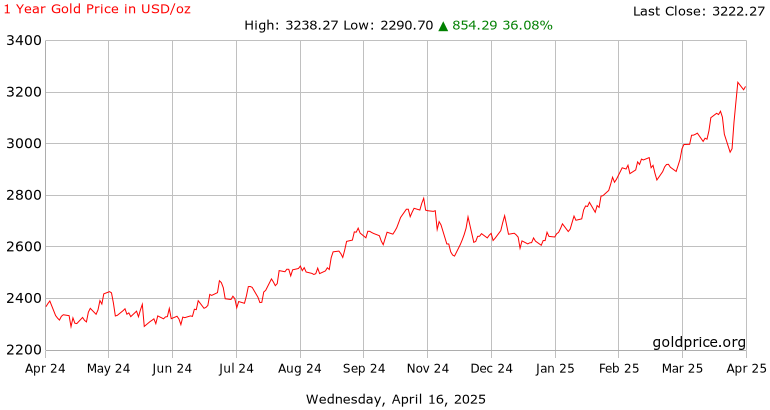Gold Reaches Historic Highs, Analysts Consider Bitcoin’s Future Amid Economic Uncertainty and Tariff Tensions
BTC
BTC/USDT
$28,176,754,200.13
$94,444.44 / $91,262.94
Change: $3,181.50 (3.49%)
+0.0053%
Longs pay
Contents
-
The current surge in gold prices has overshadowed Bitcoin, raising questions about the future dynamics between these two assets.
-
As gold approaches unprecedented heights due to economic pressures, Bitcoin’s volatility remains a topic of fervent debate among financial analysts.
-
Helima Croft from RBC Capital Markets noted, “Most of gold’s price action is around the uncertainty related to tariffs.”
This article explores the record surge in gold prices amid economic uncertainty and its implications for Bitcoin’s future as a digital asset.
What’s Driving Gold to Keep Breaking Records?
Gold’s recent ascent past $3,300 per ounce signifies more than just a market trend; it reflects a deep-seated anxiety concerning global economic stability. The record high at $3,317 per ounce marks a staggering 25% increase since the beginning of the year, driven primarily by escalating trade tensions and currency devaluation fears.

According to a report by The New York Times, the trade war has become a key driver of gold’s sustained rise, with retaliatory tariffs amplifying uncertainties in the economic landscape.
The U.S. has recently imposed new tariffs, which provoked countermeasures from major trading partners, creating a ripple effect of uncertainty across global markets.
“While general uncertainty and deteriorating economic vibes are improving interest in gold, most of gold’s price action is around the uncertainty related to tariffs,” said Helima Croft, head of global commodity strategy at RBC Capital Markets. This indicates that external economic pressures are heavily influencing investor sentiment towards gold.
The rising fears that certain tariffs might impact the gold market directly have spurred significant stockpiling. JPMorgan Chase and HSBC, for instance, are actively relocating substantial gold reserves, with JPMorgan planning to transfer about $4 billion in the coming weeks to secure their holdings.
Furthermore, a financial analysis from Zerohedge highlighted a potential catalyst in the Senate Budget Resolution for FY2025, which permits an increase in the U.S. budget deficit by as much as $5.8 trillion over the next decade. This looming uncertainty regarding financial stability contributes to heightened fears of a currency devaluation.
Goldman Sachs has not remained silent in the wake of these developments. The investment bank has accessed current market dynamics to raise its year-end forecast for gold to $3,700, driven by anticipated stronger central bank demand and mounting recessionary risks globally.
What Are Analysts Saying About Bitcoin as Gold Hits a New Peak?
In the midst of gold’s newfound highs, Bitcoin, often referred to as “digital gold”, has sparked divided opinions among financial analysts. While gold has gained significant traction, Bitcoin’s performance has seen a decline, approximately 10% below its starting value this year, in stark contrast to gold’s 20% increase.
Anthony Papillano, CEO of Professional Capital Management, suggested that despite Bitcoin’s recent struggles, its long-term potential remains promising. He noted, “History tells us Bitcoin’s returns will skyrocket past gold in the coming months,” pointing to the growing acceptance of Bitcoin as a stable investment among younger demographics.
In supporting his argument, analysts have observed a consistent pattern where Bitcoin often mirrors gold’s price movements with a lag of around 100 days. This correlation is particularly evident during phases of enhanced liquidity in the market, making Bitcoin a potential beneficiary of gold’s success.
Additionally, institutional interest in Bitcoin appears robust, with companies acquiring over 95,400 BTC in the first quarter of 2025, reflecting persistent demand in the crypto space.
However, dissenting opinions remain. Economist Peter Schiff, a long-time skeptic of Bitcoin, warned investors against cryptocurrency, advocating instead for heavy investment in gold and silver mining stocks as safer alternatives. His perspective underlines the continuing debate about the viability of Bitcoin in the wake of traditional asset surges.
Conclusion
As gold reaches unprecedented prices amid heightened economic uncertainty, the spotlight intensifies on Bitcoin’s volatile nature. While analysts reveal divergent forecasts, the tight interdependence between these two assets demonstrates the ongoing evolution of the financial landscape. Investors are urged to stay informed and consider macroeconomic indicators when making strategic investment decisions.
Marisol Navaro
Comments
Yorumlar
Other Articles
AI Data Centers May Strain Water Supplies in US High-Stress Regions
January 1, 2026 at 08:17 PM UTC
Experts Predict 12-15% Stock Gains in 2026 Despite Midterm Pullback Risks
January 1, 2026 at 05:01 PM UTC
Tether Adds Nearly 9,000 Bitcoin to Reserves in Q4 2025, Reaching 96,185 BTC
January 1, 2026 at 03:25 PM UTC
